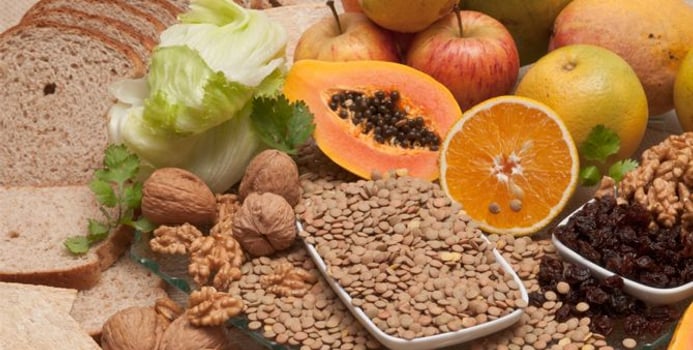Sometimes it can be a challenge to get enough fiber in your daily diet. The Institute of Medicine recommends intake for total fiber for adults 50 years and younger is set at 38 grams for men and 25 grams for women, while for men and women over 50 it is 30 and 21 grams respectively per day, related to decreased daily intake. But take up the challenge! Fiber is needed in the diet because it is not digested; instead, it works to help eliminate toxic wastes from the body.
The two types of fiber, soluble and insoluble, are needed every day. Sometimes the conception is that too much fiber can cause pain or difficulty passing stools, but this is probably related to inadequate water consumption or too much of only one type of fiber. The fibers work together to soften and move wastes through your body for excretion. Plus fiber and fiber-rich foods are usually bundled with many important nutrients and phytonutrients!
Soluble fiber is the type that dissolves in water and is associated with helping to keep your blood sugars stable and supporting heart health. Soluble fiber is found in oats, barley, psyllium seed husks, dried legumes, fruits and vegetables. Insoluble fiber is the roughage that gives plants their structure and helps move wastes through the digestive tract and is found in whole-wheat products, corn, bran, flaxseeds and vegetables like green beans, potatoes and cauliflower.
Fiber is the key element to many healthy diets. It slows your digestion, making you feel fuller longer, but since it is not digested, it doesn't add calories. High-fiber foods tend to take longer to chew, which slows your intake, and are often lower in calories, added sugar and fats.
When reading labels to choose higher fiber options, know what the claims mean.
Fiber on Labels
- High fiber: 5 grams or more per serving
- Good source: 2.5 to 4.9 grams per serving
- More or added fiber: 2.5g more added per serving
How to Get More Fiber in Your Diet
- As always, eat a large variety of foods in your diet to get enough of both fibers. Focus on fruits and vegetables.
- Read your food labels! Even though the package may state that it is whole grain or uses whole-wheat or bran, it doesn't always mean that it is a good source of fiber.
- Consume fiber at breakfast. This will help you feel fuller longer. Try oatmeal, whole-grain breads or cereals and add fresh fruit to maximize your fiber intake.
- Pack carrots, celery, peppers or other fibrous vegetables for snacks every day.
- Brown rice is a flavorful option to white rice, which has almost no fiber. If brown rice isn't your thing, try adding lentils, wild rice or other grains to your pot when you are cooking white rice.
- Read nutrition labels and choose options with more fiber. Looking at bread labels or rice packages for the best choice.
- Try new grains. Lentils, amaranth, quinoa, millet, spelt, bulgur and others are good to add to baking recipes, soups or salads.
- Use an air-popper to make popcorn, a high fiber snack. Try spray oil, garlic powder, non-caloric sweetener or sea salt for flavor to keep the snack low-calorie.
- Eat the skins! Not only do they have lots of nutrients, they are usually one of the higher fiber parts of the fruit. Potatoes are an excellent example: by leaving the skin on a medium-sized potato or sweet potato, you go from 2.3 grams to 3.8 grams of fiber.
- Puree cauliflower into a mash or make mashed potatoes with the skins on.
- Include more squashes in your diet, as these delicious vegetables can add a lot of fiber.
- Make hummus or buy pre-made to add to sandwiches or for a snack with veggie sticks.
- Stop with all the juice! Juice can be a quick way to add up calories without the same fiber benefits of whole fruits. Typically, juice has almost no fiber because it is made the insides of fruit and doesn't usually include the peel and pulp. Even smoothies made with whole fruit are better choices if you still want to have juice.
- Start experimenting with your favorite recipes. Often you can substitute whole-wheat flour for white flour, either in whole or in part of the recipe. Add oatmeal to your pancakes, muffins or meatloafs!
- Try ground flaxseeds on foods. Flavorful with lots of fiber, these are an easy add into meals or recipes.
- Beans, beans, beans! Beans are amazing sources of fiber and should become a frequent part of your diet. If you tend to associate beans with discomfort, rinse or soak the beans then discard that water. Rinse them again with fresh water and see if it helps decrease the gas.

Emily DeLacey MS, RD is a Registered Dietitian and currently working in Jamaica as a HIV/ AIDS Prevention Specialist. She attended Central Washington University for her Bachelor's Degree in Science and Dietetics and continued on after her internship to Kent State University for her Master's Degree in Science and Nutrition, with a focus on public health and advocacy. She served as a U.S. Peace Corps Volunteer in Malawi 2012-2014 working as a Community Health Advisor in a rural village, immersing in the joys of life without electricity or running water. She has been to 20+ countries and 47 of the 50 states in the US. Traveling, adventuring and experiencing new cultures has made her a passionate advocate for the equality of nutrition and wellness for all people.



